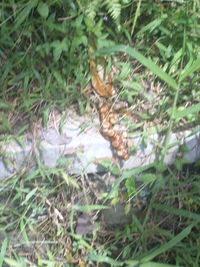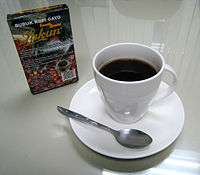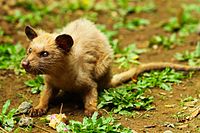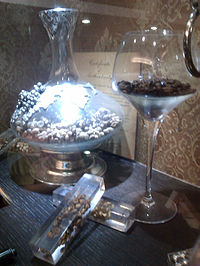- Kopi Luwak
-
 Sumatran kopi luwak farmer shows beans prior to cleaning and roasting, Sumatra, Indonesia
Sumatran kopi luwak farmer shows beans prior to cleaning and roasting, Sumatra, Indonesia
Kopi luwak (Malay pronunciation: [ˈkopi ˈlu.aʔ]), or civet coffee, is one of the world's most expensive and low-production varieties of coffee. It is made from the beans of coffee berries which have been eaten by the Asian Palm Civet (Paradoxurus hermaphroditus) and other related civets, then passed through its digestive tract.[1] A civet eats the berries for their fleshy pulp. In its stomach, proteolytic enzymes seep into the beans, making shorter peptides and more free amino acids. Passing through a civet's intestines the beans are then defecated, keeping their shape. After gathering, thorough washing, sun drying, light roasting and brewing, these beans yield an aromatic coffee with much less bitterness, widely noted as the most expensive coffee in the world with prices reaching $160 per pound.[2]
Kopi luwak is produced mainly on the islands of Sumatra, Java, Bali and Sulawesi in the Indonesian Archipelago, and also in the Philippines (where the product is called motit coffee in the Cordillera and kape alamid in Tagalog areas) and also in East Timor (where it is called kafé-laku). Weasel coffee is a loose English translation of its name cà phê Chồn in Vietnam, where popular, chemically simulated versions are also produced.
Contents
History
The origin of Kopi Luwak is closely connected with the history of Coffee production in Indonesia. In early 18th century The Dutch established the cash-crop plantations in their colony in Dutch East Indies islands of Java and Sumatra, including Arabica coffee introduced from Yemen. During the era of Cultuurstelsel (1830—1870), the Dutch prohibited the native farmers and plantation workers to pick coffee fruits for their own use. Yet the native farmers wanted to have a taste of the famed coffee beverage. Soon the natives learned that certain species of musang or luwak (Asian Palm Civet) consumed these coffee fruits, yet they left the coffee seeds undigested in their droppings. The natives collect these Luwak's dropping coffee seeds; clean, roast and grind it to make coffee beverage.[3] The fame of aromatic civet coffee spread from locals to Dutch plantation owners and soon become their favorites, yet because of its rarity and unusual process, the civet coffee was expensive even in colonial times.
Cultivars, blends, and tastes
Kopi luwak is a name for many specific cultivars and blends of arabica, robusta, liberica, excelsa or other beans eaten by civets, hence the taste can vary greatly. Nonetheless, kopi luwak coffees have a shared aroma profile and flavor characteristics, along with their lack of bitterness.
Kopi luwak tastes unlike heavy roasted coffees, since roasting levels range only from cinnamon color to medium, with little or no caramelization of sugars within the beans as happens with heavy roasting. Moreover, kopi luwaks which have very smooth profiles are most often given a lighter roast. Iced kopi luwak brews may bring out some flavors not found in other coffees.
Sumatra is the world's largest regional producer of kopi luwak. Sumatran civet coffee beans are mostly an early arabica variety cultivated in the Indonesian archipelago since the seventeenth century. The major Sumatran kopi luwak production area is in Lampung, Bengkulu and Aceh especially the Gayo region, Takengon. Tagalog cafe alamid (or alamid cafe) comes from civets fed on a mixture of coffee beans and is sold in the Batangas region along with gift shops near airports in the Philippines.
Kopi muncak
Kopi muncak (or kopi muntjak), a different type of coffee produced in a similar process, is made from the dung of barking deer (muntjac) found throughout Southeast Asia. Unlike civet coffee, Kopi muncak is mostly gathered in the wild, chiefly in Indonesian Archipelago.[citation needed]
Production
Kopi is the Indonesian word for coffee. Luwak is a local name of the Asian palm civet in Sumatra. Palm civets are primarily frugivorous, feeding on berries and pulpy fruits such as from fig trees and palms. Civets also eat small vertebrates, insects, ripe fruits and seeds.[4]
Early production began when beans were gathered in the wild from where a civet would defecate as a means to mark its territory. On farms, civets are either caged or allowed to roam within defined boundaries.[1] The capture and caging of wild civets has caused some concern within the coffee industry over witnessed accounts of animal cruelty, and there have been calls for production to become regulated to help consumers avoid contributing to unethical production methods.[5]
Coffee cherries are eaten by a civet for their fruit pulp. After spending about a day and a half in the civet's digestive tract the beans are then defecated in clumps, having kept their shape and still covered with some of the fleshy berry's inner layers. They are gathered, thoroughly washed, sun dried and given only a light roast so as to keep the many intertwined flavors and lack of bitterness yielded inside the civet.
Research
 Defecated luwak coffee berries, East Java
Defecated luwak coffee berries, East Java
Several studies have examined the process in which the animal's stomach acids and enzymes digest the beans' covering and ferment the beans.[6][7][8] Research by food scientist Massimo Marcone at the University of Guelph in Ontario, Canada showed that the civet's endogenous digestive secretions seep into the beans. These secretions carry proteolytic enzymes which break down the beans' proteins, yielding shorter peptides and more free amino acids. Since the flavor of coffee owes much to its proteins, there is a hypothesis that this shift in the numbers and kinds of proteins in beans after being swallowed by civets brings forth their unique flavor. The proteins are also involved in non-enzymatic Maillard browning reactions brought about later by roasting. Moreover, while inside a civet the beans begin to germinate by malting which also lowers their bitterness.[9][10]
At the outset of his research Marcone doubted the safety of kopi luwak. However, he found that after the thorough washing, levels of harmful organisms were insignificant. Roasting at high temperature has been cited as making the beans safer after washing.[by whom?][citation needed]
Civet coffee imitation
Research into the palm civet's digestive processes and the transformation of the beans' proteins has led to the discovery of innovative ways to imitate the taste of kopi luwak without the civet's involvement. It is a response to the decrease in civet population, caused by hunting for meat.[11][improper synthesis?] Kopi luwak production involves a great deal of labor, whether farmed or wild-gathered. The small production quantity and the labor involved in production contribute to the coffee's high cost.[12] The high price of kopi luwak is another factor that drives the search for a way to produce kopi luwak in large quantities, lowering the cost.
The University of Florida has developed a way to recreate how nature produces Kopi Luwak without the involvement of any animals. This technology has been licensed to a Gainesville Florida firm, Coffee Primero, which now produces and distributes that product at a price competitive with ordinary quality coffees.[8][13]
The Trung Nguyên Coffee Company in Vietnam, through its work in isolating the civet's digestive enzymes, has patented its own synthetic enzyme soak, which is used in its Legendee brand simulated kopi luwak coffee.[7]
Price and availability
Kopi luwak is the most expensive coffee in the world, selling for between US$ $100 and $600 per pound.[1] The specialty Vietnamese weasel coffee, which is made by collecting coffee beans eaten by wild civets, is sold at $6600 per kilogram ($3000 per pound).[14] Most customers are in Asia – especially Japan, Taiwan and South Korea.[15] Sources vary widely as to annual worldwide production.[16]
In November 2006 Herveys Range Heritage Tea Rooms, a small cafe in the hills outside Townsville in Queensland, Australia, put kopi luwak coffee on its menu at A$50.00 (US $35.00 PPP) a cup, selling about seven cups a week, which gained nationwide Australian and international press.[17] In April 2008 the brasserie at Peter Jones department store in London's Sloane Square began selling a blend of kopi luwak and Blue Mountain called Caffe Raro for £50 (US $79.00) a cup.[18] Peck in downtown Milan sells a small espresso cup for 15 euros.
As of 8 September 2011, the high-end restaurant Essence of Europe in Chengdu, Sichuan Province, China sells a two-cup serving for 498 RMB (US $80). The beans (cleaned and roasted) are certified by Indonesian export authorities and the individually sealed serving is prepared for drinking in view of the customer's table.
Coffee Primero sells their "Magic Cat" line of coffee, which is made with their exclusive process developed by the University of Florida that mimicks how nature creates Kopi Luwak without the involvement of any animals, for $15.99 per pound.
References
- ^ a b c Norimitsu Onishi (18 April 2010). "From Dung to Coffee Brew With No Aftertaste". New York Times. http://www.nytimes.com/2010/04/18/world/asia/18civetcoffee.html. Retrieved 18 April 2010. "Costing hundreds of dollars a pound, these beans are found in the droppings of the civet, a nocturnal, furry, long-tailed catlike animal that prowls Southeast Asia’s coffee-growing lands for the tastiest, ripest coffee cherries. The civet eventually excretes the hard, indigestible innards of the fruit – essentially, incipient coffee beans – though only after they have been fermented in the animal’s stomach acids and enzymes to produce a brew described as smooth, chocolaty and devoid of any bitter aftertaste."
- ^ Forbes.com Most Expensive Coffee
- ^ National Geographic Travellers Indonesia, November 2010, page 44
- ^ Ismail, Ahmad, Common palm civet, retrieved 18 February 2010
- ^ "Nordic Barisa Cup – a discussion". NBC. http://coffeeforums.co.uk/showthread.php?4197-Nordic-Barista-Cup-WFT-is-going-on-up-there.
- ^ "Kopi luwak coffee safe, U of G study finds". 26 November 2002. http://www.uoguelph.ca/news/archives/002065.html.
- ^ a b trung-nguyen-online.com, Legendee: The Legend of the Weasel, retrieved 18 February 2010
- ^ a b QUALITY ENHANCEMENT OF COFFEE BEANS BY ACID AND ENZYME TREATMENT
- ^ Marcone, Massimo, In Bad Taste: The Adventures And Science Behind Food Delicacies, 2007
- ^ Marcone, Massimo, Food Research International, Volume 37, Issue 9, pages 901–912, 2004
- ^ "Vietnam species 'risk extinction'". BBC News. 13 August 2009. http://news.bbc.co.uk/2/hi/8199997.stm.
- ^ Feature by WBAL Channel 11 television news team
- ^ Quality Enhancement of Coffee Beans by Acid and Enzyme Treatment
- ^ "World’s priciest coffee gifted to Vietnam’s VIP guests". 11 August 2010. http://vietnambusiness.asia/world%E2%80%99s-priciest-coffee-gifted-to-vietnam%E2%80%99s-vip-guests/.
- ^ McGeown, Kate (1 May 2011). "Civet passes on secret to luxury coffee". BBC News. http://www.bbc.co.uk/news/world-asia-pacific-12959381.
- ^ Sweet, Leonard (2007). The Gospel According to Starbucks. Waterbrook Press. pp. 23. ISBN 9781578566495.
- ^ heritagetearooms.com.au, Kopi Luwak, 5 September 2007, retrieved 18 February 2010
- ^ guardian.co.uk, The £50 espresso, 11 April 2008, The Guardian, accessed on 18 February 2010
External links
- University of Guelph article on the effects of the digestive system on coffee beans
- USA Today article on civet coffee
- BBC Civet coffee selling well despite SARS
- cbc.ca article on "cat poop coffee"
- BBC report In the Philippines
- ABC News item and photo report
- From Civet Poop to Great Coffee – slideshow by Life magazine
- Foreign Correspondent – 11/09/2007: Sumatra – Extreme Coffee, ABC Australia television broadcast on Foreign Correspondent
Categories:- Indonesian beverages
- Indonesian words and phrases
- Economy of East Timor
- Economy of Indonesia
- Economy of the Philippines
- Coffee varieties
- Hot beverages
Wikimedia Foundation. 2010.




